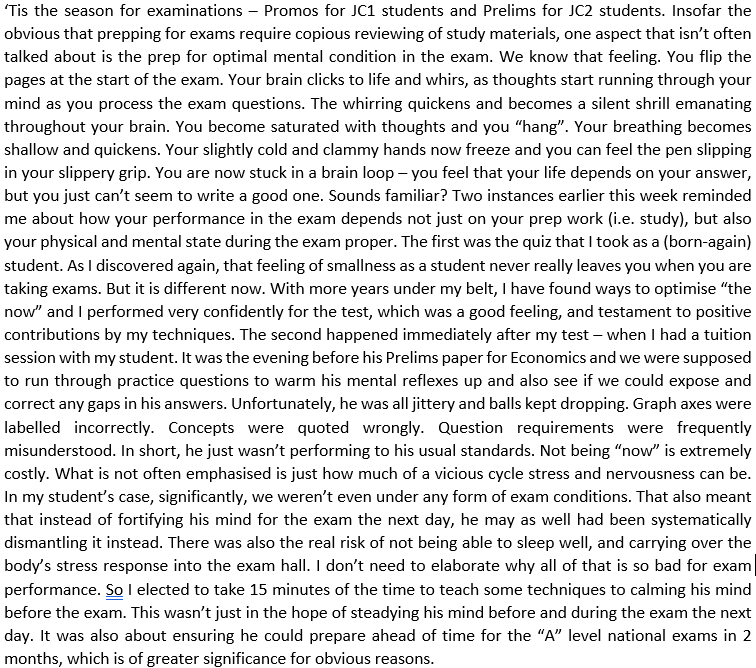A common question I get from students is on how they should be paragraphing their essays for their Economics exam:
Must 1 argumentative point always be discussed within 1 paragraph?
Well, the short answer from me is no.
Avoid wall of text.
Have you heard of the phrase “wall of text”?
If you haven’t, it means quite literally what it says – a huge chunk of non-paragraphed text that is almost impossible to read properly.
Here’s an example of me butchering my previous post to illustrate what it is:

Given the need for students to provide well-reasoned explanations and justifications for each point made in the exam, it is almost inevitable that “walls of text” happen if you had been writing only one paragraph for each broad argument point.
However you may not have noticed this because you had drawn diagrams within the answers, serving to break up the texts somewhat. But you shouldn’t count on that if you are keen on improving your writings!
As you can see, not having sufficient visual breaks is a pain to the eye, which would not help your cause with the examiner.
Or even yourself for the matter! Referencing your essays will become a nightmare, never mind the occasional post-writing corrections.
So do yourself a favour by learning how to paragraph well and confidently!
Paragraphing 101
Generally, paragraphs are used to indicate logical breaks to your writings. It acts very much like how when speaking to others, there is usually a slight pause before a next point of discussion is raised.
A key element to every paragraph is the topic sentence – which is one that summarises the gist of whole paragraph.
A topic sentence is important because it:
- Anchors the reader to the points that you are trying to make;
- Allows the reader to have a choice of “speed-reading” that actually works; and
- Improves your ability, as the writer, to navigate and ensure logical flow is maintained.
There is no hard and fast rule that dictates how you should paragraph, but given the purposes of paragraphing laid out earlier, I usually advise my students to have 1 paragraph each for:
- A point that you are trying to make (with justification and examples);
- Any further points in relation to the one you had made earlier (e.g. counter-arguments, contextual observations);
- Setting up of each theoretical framework for your points later (i.e. introduction, definitions, assumptions, scenario); and
- Conclusion (rounding up your observations and arguments – reinforcing the flavour to your essay).
Application of these rules should see good logical breaks within the essay and make for easier and more predictable reading.
Of course you can see that these rules are broad strokes – ultimately the rules can be flexibly applied. Just as importantly, you should internalise them and adapt them to your writing style for ease of application. You won’t have time in the exam to pause and think in discrete fashion such as above!
Share with us!
So how do you apply paragraphing to your essays? Know some tricks that have really helped you?
I would be keen to know more – share them with us by commenting below!


What’s Going down i’m new to this, I stumbled upon this I have discovered It absolutely useful and it has helped me out loads. I hope to contribute & help different customers like its helped me. Great job.
LikeLike
Asking questions are genuinely nice thing if you are not understanding something completely,but this post gives good understanding even.
LikeLike